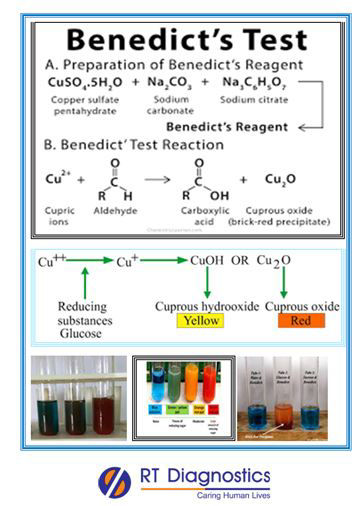Benedicts – Urine:
Why Benedict’s Urine test?
CLINICAL INFORMATION :
Benedict’stest is used to test for simple carbohydrates. It detects reducing sugars (monosaccharides – glucose, galactose, and fructose and some disaccharides i.e combination of two monosaccharides sucrose) which have free aldehyde, alpha-hydroxy-ketones, hemiacetals, or ketones as their functional group. Other tests used are Fehling’s test, Tollen’s test, etc. Benedict’sreagent or solution(contains a complex mixture of sodium citrate (Na3C6H5O7), sodium carbonate (Na2CO3), and penta-hydrate of copper-II sulfate CuSO4.5H2O)is used as a quantitative test to detect the presence of glucose in urine. A positive test with Benedict’s reagent is shown by a color change from clear blue to brick red with precipitate. Once any reducing sugar gets detected in urine further tests have to be undergone. False-positive test results can also be obtained by the presence of ascorbic acid, homogentisic acid, and other reducing substances in the urine.

General instructions:
Sample Requirement: Specimen –24 Hours urine. Test Preparation: None.
NOTE - Sample for specimen collections may vary based on the patient’s condition/cases according to the patient’s presenting complaints/signs or symptoms:
SPECIMEN REQUIREMENT (Special or Rare Cases) - As instructed and guided by Physician / Clinician / Pathologist / as per Laboratory’s requirements, according to procedures and protocols.
This Multi-Specialty Clinical Referral Laboratory RTDIAGNOSTICS provides precise and accurate tests with an extensive range of testing services to the medical centers to help in the diagnosis and identification of pathology in the test specimens for infectious diseases and also to evaluate the function of organ systems of the patient. It prevents further complications and helps to stabilize and restore health to near normalcy at the earliest without delay.



